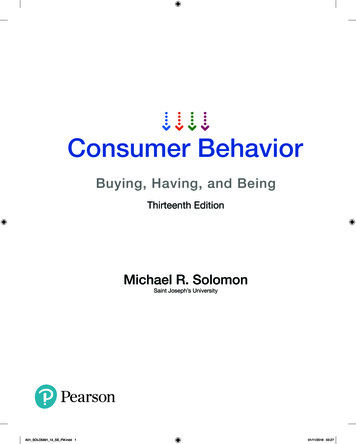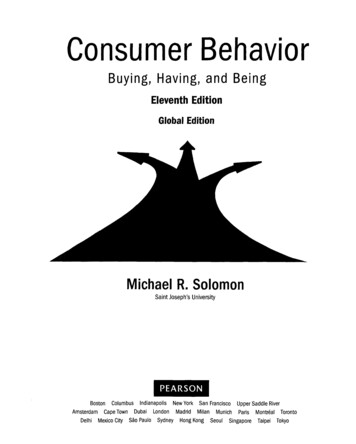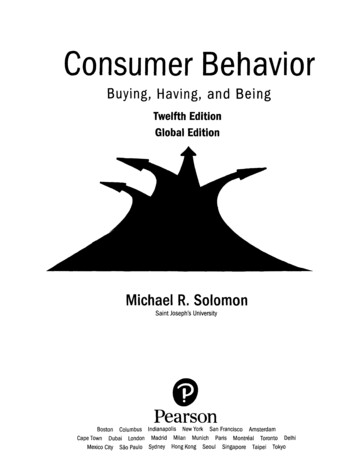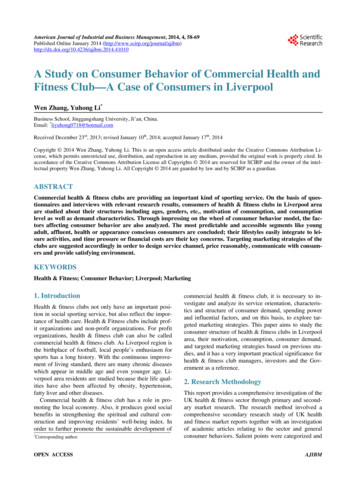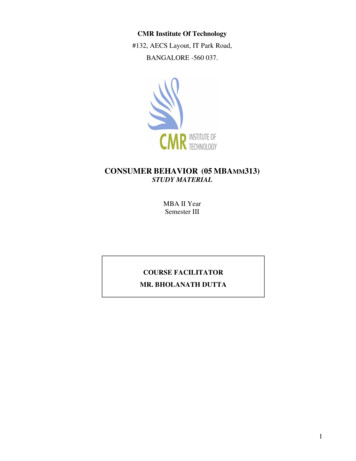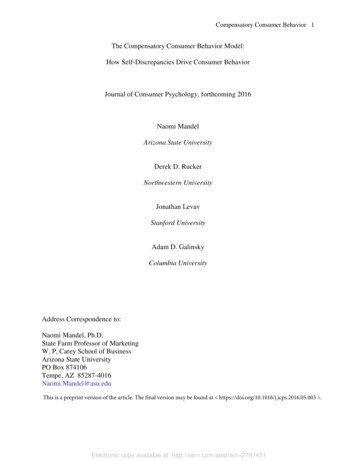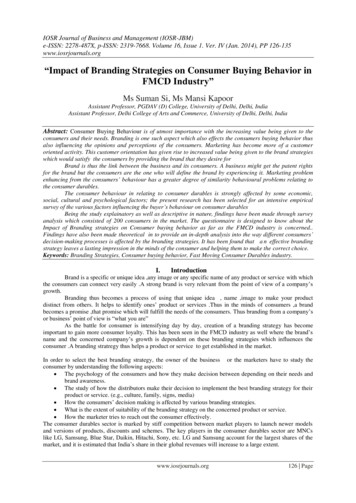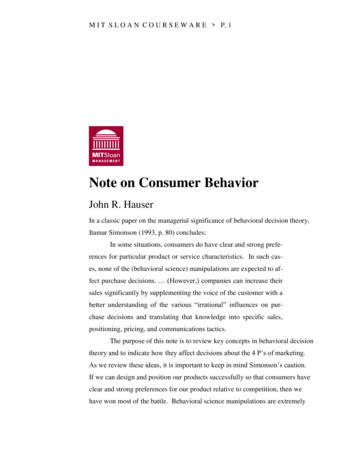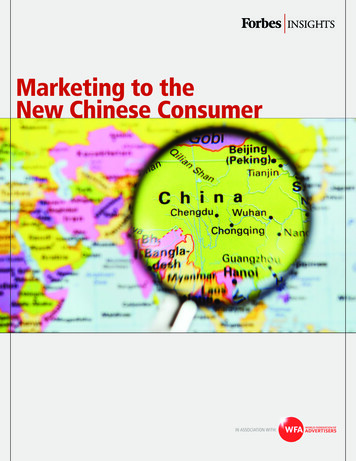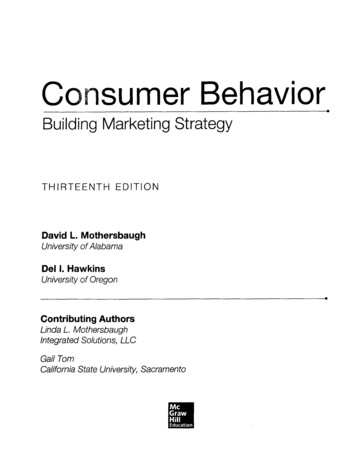
Transcription
ConsumerBehaviorBuilding Marketing StrategyTHIRTEENTH EDITIONDavid L. MothersbaughUniversity of AlabamaDel I. HawkinsUniversity of OregonContributing AuthorsLinda L. MothersbaughIntegrated Solutions, LLCGail TomCalifornia State University, SacramentoMcGrawHillEducation
ContentsPart OneIntroduction 2CHARTER ONEConsumer Behavior and MarketingStrategy 4Applications of Consumer Behavior 8Marketing Strategy 8Regulatory Policy 8Social Marketing 8Informed Individuais 9Marketing Strategy and ConsumerBehavior 9Market Analysis Components 11The Consumers 12The Company 12The Competitors 12The Conditiorts 13Market Segmentation 13Product-Related Need Sets 14Customers with Similar Need Sets 15Description of Each Group 16Attractive Segment(s) to Serve 16Marketing Strategy 17The Product 17Communications 18Price 19Distribution 20Service 20Consumer Decisions 20Outcomes 21Firm Outcomes 21Individual Outcomes 22Society Outcomes 23The Nature of Consumer Behavior 24External Influences (Part II) 24Internal Influences (Part III) 25Self-Concept and Lifestyle 26Consumer Decision Process (Part IV) 27Organization (Part V) and Regulation(Part VI) 27xviiiThe Meaning of Consumption 27Summary 29Part TwoExternal Influences34CHARTER TWOCross-Cultural Variations In ConsumerBehavior 36The Concept of Culture 40Variations in Cultural Values 43Other-Oriented Values 44Environment-Oriented Values 49Self-Oriented Values 51Cultural Variations in NonverbalCommunications 53Time 54Space 56Symbols 56Relationships 57Agreements 58Things 59Etiquette 59Conclusions on NonverbalCommunications 60Global Cultures 60A Global Youth Culture? 61Global Demographics 62Cross-Cultural Marketing Strategy 64Considerations in Approaching a Foreign Market 65Summary 68CHARTER THREEThe Changing American Society:Values 76Changes in American Cultural Values 78Self-Oriented Values 78Environment-Oriented Values 82Other-Oriented Values 86
ContentsMarketing Strategy and Values 88Green Marketing 88Cause-Related Marketing 89Marketing to Gay and Lesbian Consumers 91Gender-Based Marketing 95Summary 100CHARTER FOURThe Changing American Society:Demographics and Social Stratification 108Demographics 110Population Size and Distribution 110Occupation 112Education 112Income 114Age 115Understanding American Generations 117Pre-Depression Generation 118Depression Generation 118Baby Boom Generation 120Generation X 121Generation Y 124Generation Z 125Social Stratification 128Social Structure in the United States 129Upper Americans 129Middle Americans 132Lower Americans 134The Measurement of Social Class 136Social Stratification and Marketing Strategy 137Summary 140CHARTER FIVEThe Changing American Society:Subcultures 146The Nature of Subcultures 148Ethnic Subcultures 150African Americans 151Consumer Segments and Characteristics 152Media Usage 152Marketing to African Americans 154Hispanics 156Acculturation, Language, and GenerationalInfluences 157Marketing to Hispanics 160Asian Americans 162Consumer Segments and Characteristics 164Marketing to Asian Americans 165Native Americans 166Asian Indian Americans 168Arab Americans 168Religious Subcultures 169Christian Subcultures 169Non-Christian Subcultures 172Regional Subcultures 174Summary 175CHARTER SIXThe American Society: Familiesand Households 182The Nature and Influence of American Households 184The Influence of Households 184Types of Households 185The Household Life Cycle 186Marketing Strategy Based on the HouseholdLife Cycle 196Family Decision Making 198The Nature of Family Purchase Roles 198Determinants of Family Purchase Roles 200Conflict Resolution 201Marketing Strategy and Family Decision Making 202Consumer Socialization 203The Ability of Children to Learn 203The Content of Consumer Socialization 204The Process of Consumer Socialization 205The Supermarket as a Classroom 206Marketing to Children 207Summary 208CHARTER SEVENGroup Influences on ConsumerBehavior 214Types of Croups 216Consumption Subcultures 217Brand Communities 220Online Communities and Social Networks 222Reference Group Influences on the ConsumptionProcess 224The Nature of Reference Group Influence 224Degree of Reference Group Influence 226xix
XXContentsMarketing Strategies Based on Reference GroupInfluences 227Personal Sales Strategies 228Advertising Strategies 228Communications within Croups and OpinionLeadership 229Situations in Which WOM and OpinionLeadership Occur 233Characteristics of Opinion Leaders 234Marketing Strategy, WOM, and OpinionLeadership 235Diffusion of Innovations 238Categories of Innovations 239Diffusion Process 242Marketing Strategies and the Diffusion Process 245Summary 247Interpretation 289Individual Characteristics 290Situational Characteristics 293Stimulus Characteristics 293Consumer Inferences 296Perception and Marketing Strategy 298Retail Strategy 298Brand Name and Logo Development 299Media Strategy 301Advertisements 302Package Design and Labeling 302Summary 303 PARTTWO CASES2-1 BMW Taps the Emerging Chinese LuxuryMarket 2542-2 CVS Caremark Discontinues the Sale ofTobacco Products 2552-3 Beats by Dre Rise to the Top 2582-4 How Social Media Nearly BroughtDown United Airlines 2592-5 Rieh, Angry Blrds 2612-6 American Beagle Outfitters: April Pool's JokeTurned Reality 2632-7 Tide Goes After Green With New Pods 2652-8 Hispanic Marketing in Online and MobileFormats 267Nature of Learning and Memory 314Memory's Role in Learning 315Short-Term Memory 315Long-Term Memory 317Learning Under High and Low Involvement 320Conditioning 321Cognitive Learning 325Learning to Generalize and Differentiate 326Summary of Learning Theories 327Learning, Memory, and Retrieval 327Strength of Learning 329Memory Interference 335Response Environment 336Brand Image and Product Positioning 337Brand Image 337Product Positioning 338Product Repositioning 340Brand Equity and Brand Leverage 341Summary 344Part ThreeInternal Influences270CHARTER EIGHTPerception 272The Nature of Perception 274Exposure 275Selective Exposure 275Voluntary Exposure 279Attention 279Stimulus Factors 280Individual Factors 286Situational Factors 287Nonfocused Attention 287CHARTER NINELearning, Memory, and ProductPositioning 312CHARTER TENMotivation, Personality, and EmotionThe Nature of Motivation 354Maslow's Hierarchy ofNeeds 354McGuire's Psychological Motives 355Motivation Theory and Marketing Strategy 360Discovering Purchase Motives 361Marketing Strategies Based on MultipleMotives 362352
ContentsMotivation and Consumer Involvement 363Marketing Strategies Based on MotivationConflict 363Marketing Strategies Based on RegulatoryFocus 364Personality 365Multitrait Approach 366Single-Trait Approach 367The Use of Personality in Marketing Practice 368Communicating Brand Personality 369Emotion 370Types ofEmotions 371Emotions and Marketing Strategy 372Emotion Arousal as a Product and Retail Benefit 372Emotion Reduction as a Product and RetailBenefit 373Consumer Coping in Product and ServiceEncounters 373Emotion in Advertising 374Summary 376CHARTER ELEVENAttitudes and Influencing Attitudes 382Attitüde Components 384Cognitive Component 384Affective Component 387Behavioral Component 388Component Consistency 390Attitüde Change Strategies 392Change the Cognitive Component 392Change the Affective Component 393Change the Behavioral Component 395Individual and Situational Characteristics That InfluenceAttitüde Change 395Cue Relevance and Competitive Situation 397Consumer Resistance to Persuasion 397Communication Characteristics That Influence AttitüdeFormation and Change 397Source Characteristics 398Appeal Characteristics 400Message Structure Characteristics 406Market Segmentation and Product Development StrategiesBased on Attitudes 407Market Segmentation 407Product Development 407Summary 409CHARTER TWELVESelf-Concept and Lifestyle 418Self-Concept 420Interdependent/Independent Self-Concepts 420Possessions and the Extended Seif 421Measuring Self-Concept 423Using Self-Concept to Position Products 424Marketing Ethics and the Self-Concept 425The Nature of Lifestyle 427Measurement of Lifestyle 428General versus Specific Lifestyle Schemes 429The VALS System 430The l'ALS Segments 431Geo-Lifestyle Analysis (Nielsen PRIZM ) 434PRI2M Social and Life Stage Groups 434Sample PRIZM Segments 435An Application of PRIZM 436International Lifestyles 437Summaiy 438 PART THREE CASES3-1 Patagonia's Eco-Fashion Push 4443-2 Domino's Reformulation 4473-3 Let's Move! Campaign Celebrities EndorsingSoda?! 4483-4 Attention Millenniais! Automobile ManufacturersAdapt for You 4523-5 Is Your Dog a Cheesehead? Targeting thePremium Ret Market 4563-6 Hello Kitty Mania 4573-7 Xerox's Ongoing Battie to Reposition 4613-8 Dell Takes an Emotional Approach 4633-9 CampbeH's Targets Growing Male GroceryShoppers 465Part FourConsumer Decision ProcessCHARTER THIRTEENSituational Influences 470The Nature of Situational Influence 472The Communications Situation 472The Purchase Situation 473The Usage Situation 474The Disposition Situation 474468
xxiiContentsSituational Characteristics and Consumption Behavior 475Physical Surroundings 475Social Surroundings 480Temporal Perspectives 482Task Definition 482Antecedent States 483Ritual Situations 485Situational Influences and Marketing Strategy 486Summary 489CHARTER FOURTEENConsumer Decision Process and ProblemRecognition 496Types of Consumer Decisions 498Nominal Decision Making 500Limited Decision Making 500Extended Decision Making 501The Process of Problem Recognition 501The Nature of Problem Recognition 502Types of Consumer Problems 504Uncontrollable Determinants of Problem Recognition 505Marketing Strategy and Problem Recognition 506Discovering Consumer Problems 507Responding to Consumer Problems 509Helping Consumers Recognize Problems 510Suppressing Problem Recognition 513Summary 514CHARTER FIFTEENInformation Search 518The Nature of Information Search 520Types of Information Sought 521Evaluative Criteria 521Appropriate Alternatives 521Alternative Characteristics 524Sources of Information 524Internet Search 526Mobile Search 532Marketing Strategy and Mobile Search 533Amount of Externa! Information Search 534Costs Versus Benefits of External Search 536Market Characteristics 536Product Characteristics 537Consumer Characteristics 537Situation Characteristics 538Marketing Strategies Based on Information SearchPattems 539Maintenance Strategy 539Disrupt Strategy 539Capture Strategy 540Intercept Strategy 541Preference Strategy 541Acceptance Strategy 542Summary 543CHARTER SIXTEENAlternative Evaluation and Selection550Consumer Choice and Types of Choice Process 552Types of Consumer Choice Processes 553Evaluative Criteria 556Nature of Evaluative Criteria 557Measurement of Evaluative Criteria 559Individual Judgment and Evaluative Criteria 561Accuracy of Individual Judgments 561Use of Surrogate Indicators 562The Relative Importance and Influenceof Evaluative Criteria 563Evaluative Criteria, Individual Judgments,and Marketing Strategy 563Decision Rules for Attribute-Based Choices 564Conjunctive Decision Rule 565Disjunctive Decision Rule 566Elimination-by-Aspects Decision Rule 567Lexicographic Decision Rule 568Compensatory Decision Rule 569Summary of Decision Rules 571Summary 573CHARTER SEVENTEENOutlet Selectionand Purchase 580The Evolving Retail Scene 583Internet Retailing 584Store-Based Retailing 586The Internet as Part of a Multi-Channel Strategy 587Mobile as Part of an Omni-Channel Strategy 590Attributes Affecting Retail Outlet Selection 591Outlet Image 591Retailer Brands 594Retail Advertising 595Outlet Location and Site 597
xxiiiContentsConsumer Characteristics and Outlet Choice 598Perceived Risk 598Shopping Orientation 599In-Store and Online Influences on Brand Choices 601The Nature of Unplanned Purchases 601Point-of-Purchase Materials 603Price Reductions and Promotional Deals 604Outlet Atmosphere 605Stockouts 607Website Functioning and Requirements 607Mobile and Mobile Apps 608Sates Personnel 608Purchase 609Summary 610CHARTER EIGHTEENPostpurchase Processes, CustomerSatisfaction, and CustomerCommitment 620Postpurchase Dissonance 622Product Use and Nonuse 624Product Use 624Product Nonuse 625Disposition 627Product Disposition and Marketing Strategy 628Purchase Evaluation and Customer Satisfaction 630The Evaluation Process 630Dissatisfaction Responses 633Marketing Strategy and Dissatisfied Consumers 634Customer Satisfaction, Repeat Purchases, and CustomerCommitment 637Repeat Purchasers, Committed Customers,and Profits 639Repeat Purchasers, Committed Customers,and Marketing Strategy 642Summary 645 PART FOUR CASES4-1 Scent Marketing Reaches Consumers'Emotions 6544-2 Amazon Prime Air Prepares for Takeoff 6564-3 Target Resists the Christmas Creep 6584-4 Netflix Continues to Change the Face of In-HomeMovies around the Globe 6604-5 Macy's Embraces Beacon Technology 6614-6 Tesla's Novel and Environmental Approach DrivesAmazing Brand Loyalty 6634-7 Gilt Groupe's Innovative Approach to LoyaltyPrograms 6654-8 Albertsons Ditches Self-Checkout in Favorof Human Contact 667Part FiveOrganization as Consumers670CHARTER NINETEENOrganizational Buyer Behavior 672Organizational Purchase Process 674Decision-Making Unit 674Purchase Situation 676Steps in the Organizational Decision Process 678The Internet's Role in the OrganizationalDecision Process 684Organizational Culture 684Externa! Factors Influencing Organizational Culture 685Firmographics 685Culture/Government 688Reference Croups 688Internal Factors Influencing Organizational Culture 689Organizational Values 689Perception 690Learning 691Motives and Emotions 692Organizational Buyer Segments and MarketingStrategy 692Summary 695 PART FIVE CASES5-1 RAEX LASER Steel 7015-2 Paccar—MoreThan ShinyTrucks 702Part SixConsumer Behavior and MarketingRegulation 704CHARTER TWENTYMarketing Regulation and ConsumerBehavior 706Regulation and Marketing to Children 708Concems about the Ability of Children to ComprehendCommercial Messages 709Concerns about the Effects ofthe Contentof Commercial Messages on Children 711
xx
Consumer Behavior Building Marketing Strategy THIRTEENTH EDITION David L. Mothersbaugh University of Alabama Del I. Hawkins University of Oregon Contributing Authors Linda L. Mothersbaugh Integrated Solutions, LLC Gail Tom California State University, Sacramento Mc Graw Hill Education . Contents Part One Introduction 2 CHARTER ONE Consumer Behavior and Marketing Strategy 4 File Size: 328KBPage Count: 8
